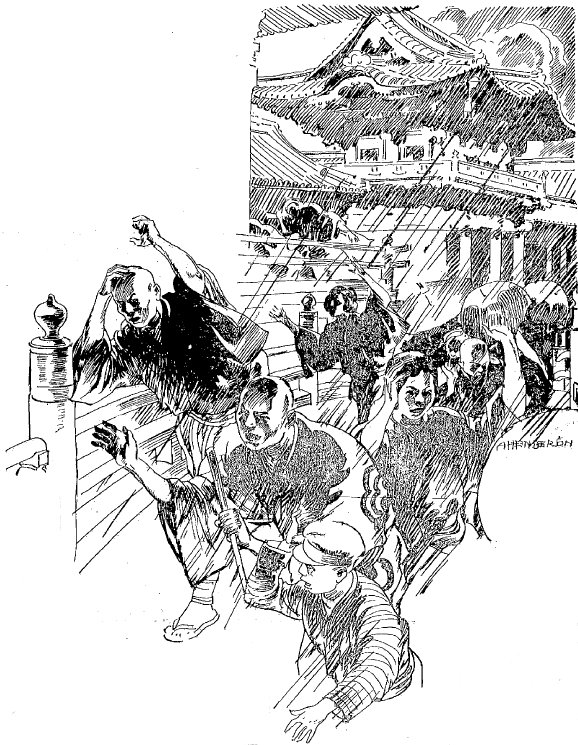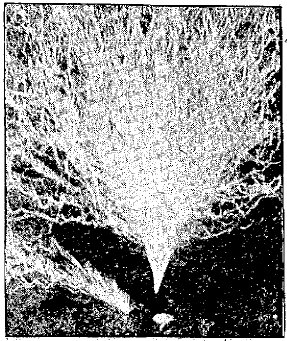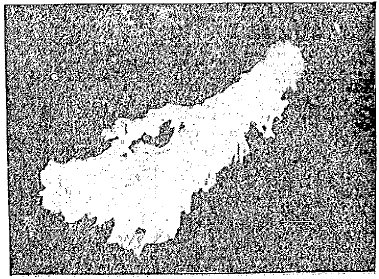Science Strives to Fathom the Peculiar Phenomena Noted Recently in the Land of Nippon, Where the Natives Were Aghast With Apprehension at the Downfall of a Fluid "of the Nature of Blood Rather Than of Colored Water"
- The fall of "thunderstones."
- The false lights of Durham.
- The "live stones of London."
- The appearance of wheels of light.
- Rains of fishes.
- What fell from the sky at Amherst, Mass.
- "Phantom Zeppelin" of Burlington, Vt.
- "Ice stones", of Tarbes.

WHEN a recent dispatch from Tokio brought news of the fall of a "red rain" in the interior of Japan—"a rain which appeared to partake of the nature of blood rather than that of water"—there were many who attributed the phenomenon either to the everwrought imagination of the natives or took it for granted that, in some way, red volcanic dust had become mixed with cloud moisture and the "red rain" had resulted.
But the investigations of a number of meteorologists and others who are interested in running down phenomena of this kind developed two facts very clearly. In the first place, the "red rain" had fallen. It was no figment of the imagination. Secondly, the "rain" was not of the ordinary consistency of water, but considerably thicker—a thick, viscous liquid, that clung and stuck, instead of running off in a solid stream.
There have been numbers of other cases in which "red rains" have fallen, and these are by no means the only unusual precipitations from the sky, for the list of "riddles" of this kind runs well up into the hundreds and embraces objects all the way from tiny globules of gelatinous matters to rocks and stones in a considerable size which have either rained down from a cloudless sky or have fallen in the midst of violent storms.

To the latter variety belong the "thunderstones," the basis of one of the most deeply seated beliefs of races whose folklore goes back for many hundreds of years that stones are cast from the sky during thunderstorms of certain kinds and that these stones are to be found where particularly heavy bolts of lightning have struck. In the tongues of the natives of Holland, Belgium, France, Sumatra and Siberia they are referred to as "thunderstones." In the early litterature of England and Scotland they are called "thunder axes." The Spaniards and the Portuguese call them "lightning stones," the Brasilians "lightning flashes," the natives of Slavonia "sky arrows" and those of Amboina "thunder teeth." But in each case the premise is the same—signes cast from the sky and accompanied by brilliant flashes of lightning.
APPARENTLY, occurences of this kind are impossible, for they contradict all the laws of nature as we know them. But there cannot be the slightest doubt that they have occured upon numerous occasions, for, in addition ot the legend which is to be found in the folklore of almost all primitive peoples, there are a score of more of recent well-authenticated instances where "thunderstones" have actually fallen.
One of the most remarkable of these was observed near Wolverhampton, England, in the fall of en , when to quote the report in Nature and in the London Times, "a huge ball of what appeared to be green fire fell during a severe windstorm, otherwise unaccompanied by lightning." Several persons who had witnessed the fall of the "ball of green fire" visited the spot where it had struck and found "a highly polished stone, totally different from any mineral deposits in the vicinity and equally different, from any meteorite in existence." Possibly, argued those who maintained that stones could not possibly fall from the sky, this particular stone had been there all the time. But, if it had been, the coincidence of the lightning striking directly above it—to say nothing of uncovering it to the gaze of those who had never seen it before—was almost as inexplicable as would have been its fall from the upper air.

Blinkenburg in his treatise on the subject of "Thunderstones" gives many similar instances, including the finding of stone axheads under trees that have been struck by lightning in Malacca, Sumatra and Java, while in Central Africa wedge-shaped, highly polished objects described as "axes" have been found stricking in trees which have been hit by what seemed to be lightning. Nor have these occurences been limited to Asia and Africa, for there are two officially authenticated instances of similar happenings in Prussia during the early part of the last century, while Meunier tells of one "axhead" in his possession that fell during a storm in Sicily, while a stone of eight pounds in weight fell in London in en . All of these "thunderstones" varied widely from the mineral deposits in the neighborhood, and science has been unable to account for the appearance or origin of any of them.
THEN, in addition to the "thunderstones," there are the phenomena grouped under the heading of "live stones," which have been noted on a number of occasions—missiles which seemed to have an activity of their own, dropping from the air much as if they had been loosed from some airplane scaring at a height that made it invisible.
Possibly the best-known instance of this kind—and there have been a number reported by witnesses of
unimpeachable character—is that referred to in the London Times of le . From 4 o'clock
Thursday afternoon until half past 11 Thursday night,
states this account of the strange occurence, the
houses at 56 and 58 Reverdy road, Dermondsey, were assailed with stones and other missiles coming from and unseen
quarter. Two children were injured, every window in the two houses broken and several articles of furniture
destroyed. Although there was a strong body of policemen scattered through the neighborhood and a cordon of them
thrown around the houses in question shortly after 8 o'clock, they could find no trace of the course of the
bombardment and could discover no clue that would throw the least light upon the mystery. Eyewitnesses stated that
the stones appeared to be almost alive.
Other similar occurences took place at Palestine, Tex., in en ; at Hills-boro, Ill., in en , and at Kingston, Jamaica, in en . At Bismarck, S. D., on the evening of le , the city was startled by a "shower" of flinty stones which seemed to fall from the air, and fifteen minutes later another rain of stones occured in the same city, but over a slightly different area. On none of these occasions was an explosion reported near at hand or any other natural explanation advanced for the appearance of the stones which seemd to be endowed with a life and activity of their own.
The famous "ice stone" of Tarbes is another of the strange phenomena which belong to much the same category. This stone fell in the midst of a violent storm at Tarbes, France, on the afternoon of le , or, at least, it was naturally supposed that it had fallen during the storm, for a passer-by picked it up immediatly afterward because his attention was attracted by the fact that it was covered with ice, in spite of the unseasonable warmth of the day.
At first it was thought that it was a large hailstone which, through some freak of climatic conditions, had fallen by itself. But as the outer coating of ice melted it was seen that inside there was a stone or pebble, described by M. Sudre, professor of the Normal School of Tarbes, as being five millimeters thick and thirteen millimeters in circumference, with a weight of two grammes. But the most amazing part of the mystery was not the presence of the ice-covered stone, unusual as this was, but the fact that the stone itself had been cut and shaped by some means at least similar to human mentality, while upon the disc appeared a number of characters, clearly but not deeply engraved—charaters which correspond to no writing known to history.
Scientists puzzled over the problem. The members of the French Academy discussed the matter from all angles. It was treated at length in the annals of the Society of Meteorologists, in La Nature and in L'Année Scientifique, but without producing the slightest explanation which would tend to show how the stone could have come to the spot where it was found. Its characters underciphered, its origin untraced, the "ice stone of Tarbes" remains to this day a puzzle which has defied all attempt at solution.
Talking equal rank with it as a riddle of the sky is the "thing" which fell at Amberst, Mass., on le . This object, which was admittedly unlike anything else which had been previously observed, was said to have fallen accompanied by a brilliant light and was examined and discussed by a number of learned men, among them Prof. Graves, of Dartmouth College.
The object itself was bowl-shaped, about eight inches in diameter and from an inch to an inch and a half in thickness, bearing upon it a nap similar to that of finely woven cloth. Upon removing this nap a buff-colored pulpy substance was found. This gave off an offensive odor and upon exposure to the air turned a vivid red and soon disintegrated.
In the American Journal of Science for en there may be found Prof. Graves' account of this phenomenon, accompanied by corroborative evidence from scientists who examined "the thing from the sky" before its general disintegration. Their evidence may be summarized as follows: On the evening of August 8 a bright light, somewhat similar to a flush of lightning, but unaccompanied by thunder of even a storm cloud, was seen in various parts of Amherst. Outside of Prof. Dewey's house there was heard a sound as if some fairly heavy object had struck the ground, followed by a slight explosion. The next morning, in the yard in front of the Dewey house, was found "a substance unlike anything before observed by any one who saw it" and containing "a buff-colored pulpy substance of the consistency of soft soap, which exuded an offensive, suffocating smell. After a few moments exposure to the air this substance changed to a livid color resembling venous blood, absorbing moisture quickly from the air and liqueflying." Whence it came or what it was no one has ever discovered.
A NUMBER of years later, on the morning of le , an event took place in Rath County, Ky., which appeared to be contrary to all known laws of nature, but which was witnessed and vouched for by hundreds or persons—the fall from a clear sky upon a strip of land 100 yards long and some fifty yards wide of a large number of flakes of a substance that seemed to be of the texture of raw beef. The "flakes" were of varying size, ranging in general from one to four inches square, though one flake which was preserved and subsequently subjected to microscopic analysis was five inches long by about three inches in width.
In addition to the fact that these flakes descended out of a cloudless sky, the witnesses to the phenomenon agreed that nothing but this falling substance waas visible in the sky at this time. There were no hunters in the vicinity and no large flock of birds overhead to account for the sudden rain of fleshy substance—and, even if there had been, it would hardly have been possible for the flesh of the birds to have been cut away in such even slices of uniform width. Also, there was the question of why it should have fallen only on a narrow strip of land.
Naturally, the strange event attracted widespread scientific attention and a number of theories were advanced to account for it. Prof. Lawrence Smith, of Kentucky, said that it "resembled the spawn of some reptile," but admitted that he was unable to name the species.
And there science has been compelled to permit "the Kentucky phenomenon" to rest—a remarkable occurence, which defies explanation by any known theory.
Among the many authenticated accounts of "rains of fishes," that which occured at Singapore, in the Straits Settlements, on le , is probably the most remarkable. Following as earthquake which devastated a considerable portion of the city there came so extraordinary downpour, resulting in the accumulation of as much water as would be contained in a lake of considerable size. For three days and nights this rain came down in torrents, and in the pools which it formed upon the ground large numbers of fish were found.
ANOTHER phenomenon of the air of a totally different kind took place at Farlington, Vt., on le , when a terrific explosion was heard throughout the city and what seemed to be a ball of light was seen to fall either from the sky or from some huge torpedo shaped object. The "ball of light" exploded as it struck the earth with a detonation that was audible for miles.
Bishop John S. Michaud in giving his impressions of the strange occurence said: "I was standing engaged in conversation with former Governor Woodbury and A. A. Buell, when, without the slightest warning, we were startled by what seemed to be a terrific explosion, evidently very close to us. Looking eastward along College street I observed a torpedo-shaped body, stationary in the air, about fifty feet above the tops of the buildings. It appeared to be about six feet long, the shell or covering having a dark appearance, with here and there tongues of fire issuing from spots on the surface which resembled red-hot, unburnished copper. Although stationary when first noticed, this object soon began to move and finally disappeared southward. As it moved the covering seemed to rupture in places and through these ruptures intensely red flames issued."
Copyright to Public Ledger Company.